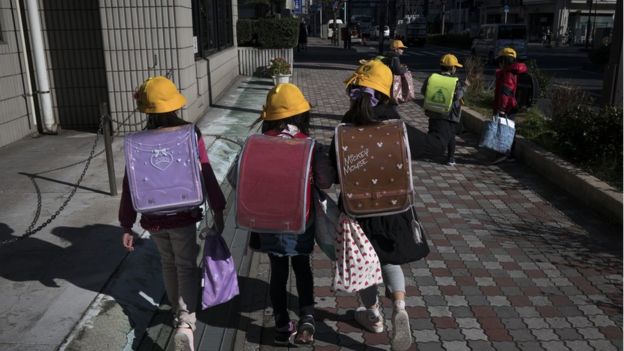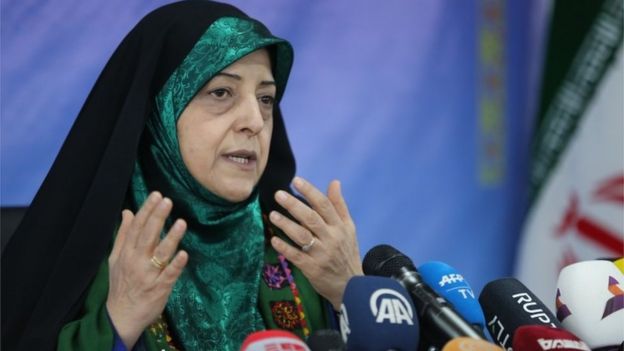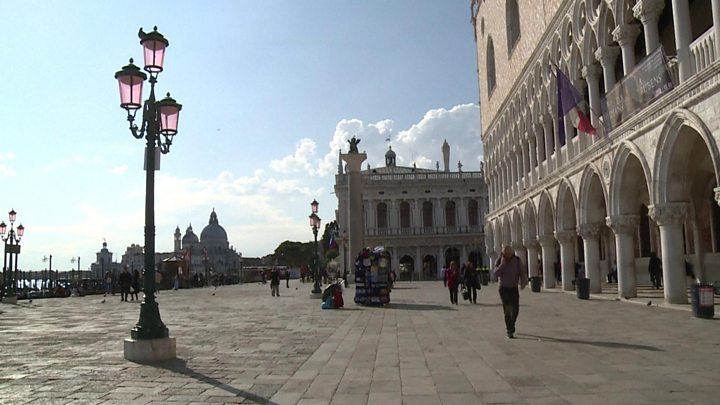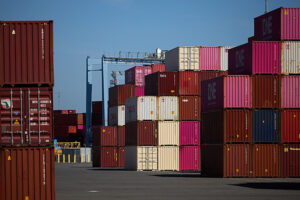Coronavirus: Outbreak at ‘decisive point’ as WHO urges action

The coronavirus outbreak has reached a “decisive point” and has “pandemic potential”, World Health Organization head Dr Tedros Ghebreyesus says.
His comments come as countries around the world battle to prevent the virus spreading further.
For a second day, more cases have been reported outside than inside China.
Iran and Italy have become major centres of infection, with people travelling from there spreading the virus further afield.
Several high-profile Iranian officials have become infected, the latest being Vice-President for Women and Family Affairs Masoumeh Ebtekar.
“It’s what’s happening in the rest of the world that’s now our greatest concern,” Dr Tedros said.
- As it happened: Updates as cases spread around world
- How close are we to a pandemic?
- What you need to know
Globally, more than 80,000 people in nearly 50 countries have been infected. Nearly 2,800 have died, the majority in China’s Hubei province.
Meanwhile stock markets around the world have fallen sharply amid fears that increased travel restrictions will prevent business activity.
What did the WHO say?
Dr Tedros urged governments to act swiftly and aggressively to contain the virus.
“We are actually in a very delicate situation in which the outbreak can go in any direction based on how we handle it,” he said.
“This is not a time for fear. This is a time for taking action to prevent infection and save lives now,” he added.

What measures are countries taking?
- Japan and Iraq have ordered schools to close – a measure already taken in mainland China and Hong Kong
- Saudi Arabia is stopping foreign pilgrims from entering the country. It is not clear if the Hajj pilgrimage, which begins in July this year, will be affected
- Iran has urged citizens to avoid making unnecessary trips within the country and cancelled Friday prayers in Tehran and other cities
- Australia is extending a ban on foreign visitors from mainland China
- Italy, where 17 people have died, has quarantined 11 towns
- Greece is cancelling all carnival activities
How will Japan’s school closures work?
The closures are set to take effect on Monday and will last until the end of spring vacation – typically in early April. The move will affect about 13 million students.
Japanese Prime Minister Shinzo Abe said the first weeks of March would be an “extremely critical period” for preventing virus transmission.
It follows China’s decision not to reopen schools on the mainland after the Spring Festival holiday and instead ask nearly 200 million students to follow classes online from their homes. Hong Kong is also keeping schools closed until April.
 Image copyrightGETTY IMAGES
Image copyrightGETTY IMAGESMany parents in Japan are concerned about what they will do with their children.
“My honest feeling – all schools on break? It’s important to protect children, but what happens if they have working parents?” one parent wrote on social media.
Officials say child day care centres and after-school facilities can remain open.
More than 200 people have so far been infected with the coronavirus in Japan. One woman in her forties in Osaka is said to have tested positive for a second time after earlier recovering.

What is happening in Iran?
Tehran has announced 26 deaths and 245 confirmed cases. Several officials are among those infected, including Ms Ebtekar and Deputy Health Minister Iraj Harirchi.
Two MPs, one of whom represents the holy city of Qom – where many of the confirmed cases have been recorded – have also reportedly been infected.
Ms Ebtekar’s symptoms are reportedly not severe and she is not in hospital.
 Image copyrightAFP
Image copyrightAFPThe WHO’s Michael Ryan said the extent of infection in Iran “may be broader than we think”.
But he said the country had a “very high clinical capacity” and the current 10% death rate for cases there probably reflected screening that was not picking up mild coronavirus cases.
Health ministry spokesman Kianush Jahanpur called on Iranians to avoid “unnecessary trips inside the country”.
Iran’s neighbours have closed their borders. The UAE, Kuwait, Bahrain, Lebanon, Afghanistan, Pakistan and Estonia in northern Europe all recorded new cases of the virus in people travelling from Iran.

Italy fights back against ‘epidemic of misinformation’
Mark Lowen, BBC Rome correspondent
Italy’s government is in fightback mode, trying a concerted approach to lessen the coronavirus panic. The foreign minister warned that an “epidemic of misleading information” would damage Italy “more than the virus itself”, which, he added, had infected 0.1% of towns in the country. “It’s time to stop the panic”, said the prime minister, asking the national broadcaster Rai to “tone down”.

On the front pages of Italian newspapers, the top story is no longer the rising number of cases but appeals for calm. The mayor of Milan, where many hotels and restaurants are half-empty, has called for some museums to reopen. A new video released by the authorities shows vibrant scenes from the city with the message: we’re not afraid and we’re open for business.
But this is a story driven by perceptions. And with Donald Trump mentioning possible future travel restrictions to Italy, with Israel barring foreigners arriving on flights from Italy, with Kuwait evacuating its nationals from Milan, the Italian government faces a challenge to change the narrative.

What is happening elsewhere?
China reported 29 more deaths and 433 new cases on Thursday. It has ordered people arriving in Beijing from affected countries to self-quarantine.
South Korea saw new cases bringing its total infections to 1,261 with 12 deaths. Singapore said a 12-year-old student at the top Raffles Institution school was among three new cases, bringing its total to 96.
In Europe, Italy had 650 infections and 17 deaths. Several countries including Algeria, Denmark, Romania and Spain have reported infections linked to Italy.
France‘s President Emmanuel Macron said the country was “facing a crisis, an epidemic that is coming”. The country now has 38 confirmed cases and two deaths. France is the world’s most visited country.
Northern Ireland diagnosed its first case bringing the total in the UK to 16.
The first case has been confirmed in The Netherlands. The person recently visited the Lombardy region of Italy.
Latin America recorded its first case in Brazil, in a person who had returned home from Italy.
The US has recorded its first confirmed case of “unknown origin”, the 60th in the country overall. The unidentified person in California had “no relevant travel history or exposure to another known patient” with the virus, officials said.
During a news conference on Thursday, US Vice-President Mike Pence said the threat to the public remains low. The White House has started discussions with leaders of US Congress on a spending bill to fight the spread of the virus, he said.
But President Trump appeared to downplay concerns of an epidemic in the US.
“I think that there’s a chance that it could get worse, a chance it could get fairly substantially worse, but nothing’s inevitable,” he said on Wednesday.
![]()





